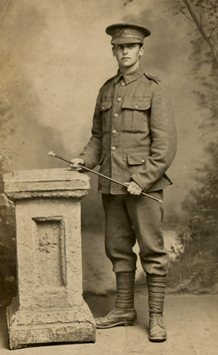
Thursday 29 January 2009
Third guards platoon

Wednesday 28 January 2009
East Africa: British Infantry

Friday 23 January 2009
Musketeer, Great War Miniatures and Renegade British
 28mm Bantam confronts 40mm policeman
28mm Bantam confronts 40mm policeman

Wednesday 21 January 2009
Early War British Infantry: Woodbine Design Company


Serge Uniform Section Pack (Service Cap)
They come in packs of 10 and there are at least 8 poses illustrated on the website. No command or support yet though. These look similar in bulk to the Renegade figures but with better hats. They have got the pack right at least. the hands look horribly big but it could just be the way the photo has come out.
If I ever do the Turkish front then the Woodbine figures would be worth looking at as their Turkish army figures are the most complete range out there but for the Western Front I will look elsewhere I think.
Early War British Infantry: Musketeer Miniatures
Musketeer Miniatures range originated last year as an Ireland 1916 range. They are sculpted by Paul Hicks. Recently they have said that they will be expanding the range into a full BEF range and doing Germans as well. So far they have the following available:
 BEF 03 british Infantry advancing
BEF 03 british Infantry advancing BEF 04 British Infantry firing
BEF 04 British Infantry firingEarly War British Infantry: Great War Miniatures
 B100 Officers and NCOs
B100 Officers and NCOs B101 Infantry Advancing
B101 Infantry Advancing B102 Infantry Skirmishing
B102 Infantry Skirmishing B103 Vickers gun and three crew
B103 Vickers gun and three crew Renegade on the left GWM on the right. Note the differences in hat proportions, the brim should be wider than the peak.
Renegade on the left GWM on the right. Note the differences in hat proportions, the brim should be wider than the peak. Early War British Infantry: Renegade Miniatures
Renegade
The first ones on the market were the Renegade figures and I already have a couple of dozen of these. They have the following appropriate figures:




Tuesday 20 January 2009
Which figures for The Great War?
Uniforms and (particularly) equipment changed a great deal during The Great War and added to this are the variations for different climates in theatres such as Africa and the Middle East.

BEF troops in 1914
Early War Western Front

Early colour photograph of French Troops in Horizon Bleu
Mid War Western Front
This covers the period of the first trench lines going up December 1914 to January 1916. British wearing the softer cap with flaps, the French moving to Horizon Bleu and the Adrian Helmet. The Germans removing the spikes on their helmets. The need for gasmasks.
 German soldier at Verdun 1916
German soldier at Verdun 1916
Late War Western Front
Sunday 4 January 2009
Mark IV Tank 2

I've now spray undercoated the Mark IV. As I did it outside in the dark I need to touch up a few little bits which the paint missed in good light and then it will be ready for painting. I still have to undercoat the beam for the rear (stern? they are His Majesty's Land Ships after all!).
The tank now sits properly as I weighted the inside with a stack of steel washers.

Gamburd commented on my previous post that the battle around Fontaine during the Cambrai offensive in November 1917 would make a good scenario. This is very true. I am attracted to the Cambrai assault as the British troops were largely Highlanders and these would make interesting looking infantry (and no tartan to paint, thank goodness, as the kilts had a khaki cover). The only problem with depicting Fontaine is that many of the British tanks were destroyeded by lorry mounted German light anti-aircraft guns and I have no idea how I would model this accurately!
Thursday 1 January 2009
Tank!









